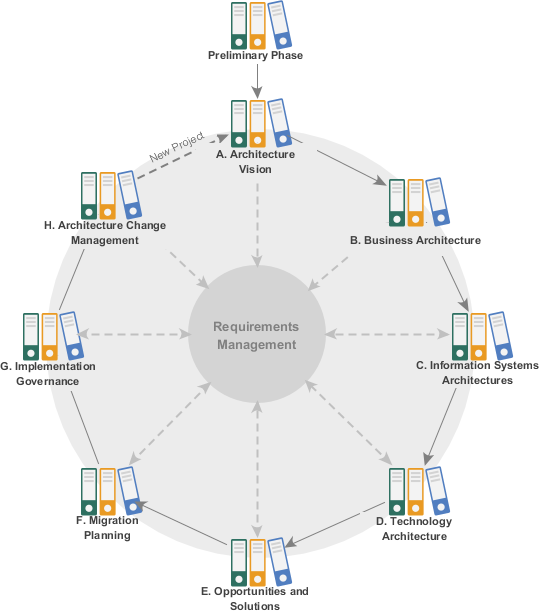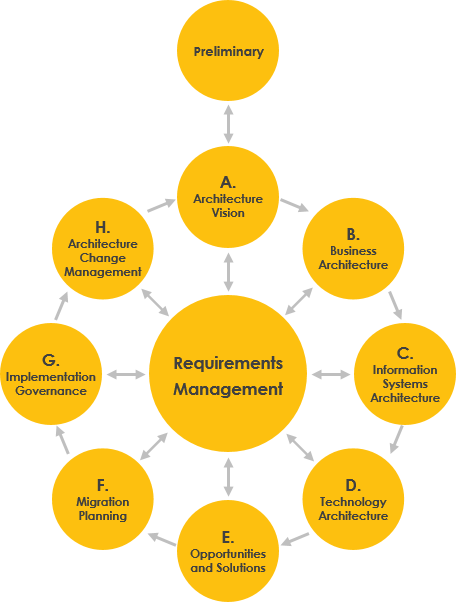TOGAF vs. Zachman Framework: Unraveling Enterprise Architecture Content Frameworks
1. TOGAF (The Open Group Architecture Framework):
Overview:
- TOGAF is a comprehensive methodology for developing and managing enterprise architectures.
- It provides a structured approach, guidelines, and best practices for creating, documenting, and evolving architectures.
- TOGAF is widely adopted and recognized as an industry standard.
Content Framework:
-
TOGAF defines a content framework that includes:
- Architecture Development Method (ADM): A process lifecycle for creating and managing architectures.
- Work Products or Artifacts: Deliverables produced at each phase of the ADM.
- Architecture Description: A structured representation of an architecture.
Pros:
- Comprehensive: Covers the entire architecture development lifecycle.
- Flexible: Can be adapted to different organizational contexts.
- Industry Standard: Widely accepted and used globally.
Cons:
- Complex: The full TOGAF framework can be overwhelming for smaller organizations.
- Methodology-Heavy: Requires adherence to a specific process.
2. Zachman Framework:
Overview:
- The Zachman Framework is an enterprise ontology that provides a structured way of viewing and defining an enterprise.
- It was developed by John Zachman in the 1980s and has evolved over time.
Content Framework:
- The Zachman Framework is not a methodology; it is an ontology.
- It organizes architectural artifacts based on two dimensions:
- Primitive Interrogatives: What, How, When, Who, Where, and Why.
- Reification Transformations: Identification, definition, representation, specification, configuration, and instantiation.
Pros:
- Holistic View: Captures multiple perspectives involved in enterprise architecture.
- Flexible: Allows customization and extensions.
- Stakeholder-Centric: Considers both who the artifact targets and what issue it addresses.
Cons:
- Lack of Methodology: Does not prescribe a specific method or process.
- Complex Matrix: The 6×6 matrix format can be challenging to navigate.
Let’s compare the TOGAF and Zachman Frameworks side by side in a table:
| Aspect | TOGAF (The Open Group Architecture Framework) | Zachman Framework |
|---|---|---|
| Purpose | Comprehensive methodology for EA design, planning, implementation, and governance. | Structured ontology for viewing and defining an enterprise. |
| Methodology vs. Ontology | Methodological approach with actionable steps (ADM). | Ontological framework without a specific methodology. |
| Coverage | Extensive coverage of architectural domains. | Holistic view across multiple perspectives. |
| Stakeholder Focus | Emphasizes architectural process. | Focuses on various viewpoints. |
| Industry Standard | Widely accepted and recognized. | Developed by John Zachman. |
| Flexibility | Adaptable to different organizational contexts. | Allows customization and extensions. |
| Pros | – Comprehensive and modular approach. – Prevents vendor lock-in. | – Holistic view. – Stakeholder-centric. |
| Cons | – Complexity for smaller organizations. – Methodology-heavy. | – Lack of methodology. – Complex matrix format. |
Ultimately, the choice between these frameworks depends on your specific needs, organizational context, and preference for either a comprehensive methodology (TOGAF) or a stakeholder-centric ontology (Zachman Framework).
3. Choosing Between TOGAF and Zachman:
- TOGAF is suitable for organizations seeking a comprehensive, process-driven approach.
- Zachman Framework is ideal for those who want a stakeholder-centric, ontology-based view.
In summary, both frameworks have their merits. TOGAF provides a robust methodology, while the Zachman Framework offers a unique perspective. Organizations should choose based on their specific needs, context, and maturity level.
Jump-Start TOGAF ADM Projects with Visual Paradigm
Enterprise Architecture is a crucial aspect of every business, but it can be challenging to master. The question of whether you can learn Enterprise Architecture independently may cross your mind. Visual Paradigm is here to help you in this journey. With an intuitive TOGAF ADM process navigator, developing Enterprise Architecture using Visual Paradigm is like having a tutor sit alongside you, guiding you through each instruction and example.

Visual Paradigm simplifies the process of becoming an enterprise architect, even without any formal training. An actionable guide walks you through the process, complete with instructions, tips, samples, and case studies. As you read through this tutorial, you’ll see how the best TOGAF software helps you perform TOGAF activities and produce TOGAF deliverables with ease.
What Visual Paradigm Offers
Visual Paradigm offers a comprehensive set of features to facilitate the TOGAF ADM process:
- An ADM process navigator that guides you through the development of enterprise architecture with TOGAF ADM, activity by activity, step by step.
- Assists you in creating deliverables and artifacts, with clear instructions.
- Generates deliverables upon completion of an ADM phase.
- Automatically archives deliverables in an Architecture Repository.
- Provides samples to help you understand TOGAF.
- Offers the tools and diagrams you need for analysis and documentation, including ArchiMate 3 diagram tools and viewpoints (The Open Group certified), Implementation Plan Diagram, Migration Roadmap, Maturity Analysis, PERT Chart, RACI Chart, Implementation Factor Assessment & Deduction Matrix, Consolidated Gaps, Solutions, & Dependencies Matrix, and more.
Visual Paradigm is a powerful tool that simplifies the process of learning and implementing Enterprise Architecture. With clear instructions, samples, and essential tools, it makes the journey of becoming an enterprise architect a breeze.



